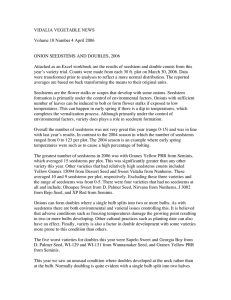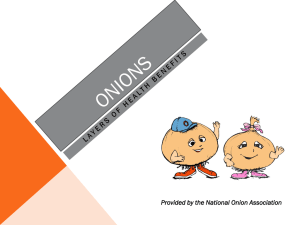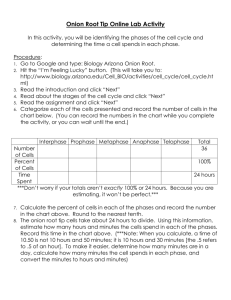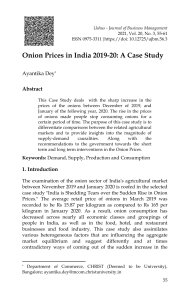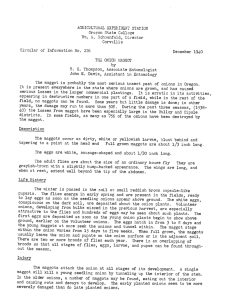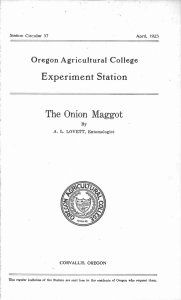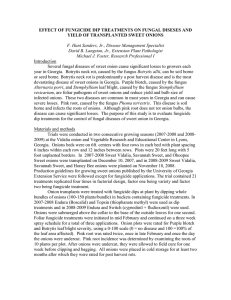Paperless Office
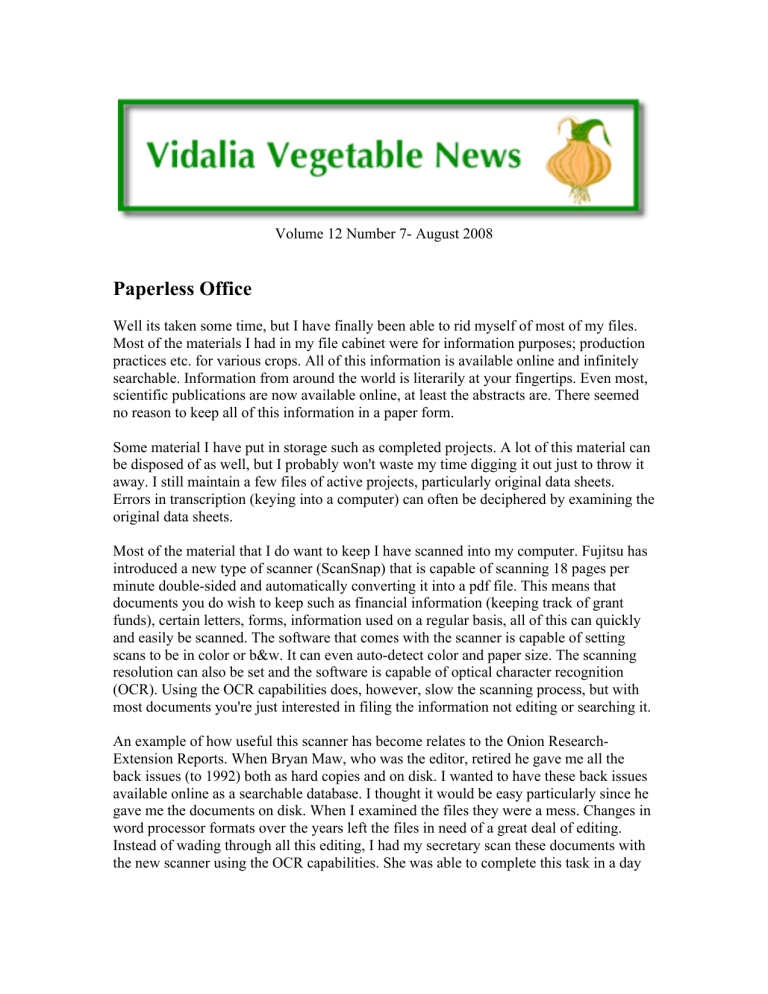
Volume 12 Number 7- August 2008
Paperless Office
Well its taken some time, but I have finally been able to rid myself of most of my files.
Most of the materials I had in my file cabinet were for information purposes; production practices etc. for various crops. All of this information is available online and infinitely searchable. Information from around the world is literarily at your fingertips. Even most, scientific publications are now available online, at least the abstracts are. There seemed no reason to keep all of this information in a paper form.
Some material I have put in storage such as completed projects. A lot of this material can be disposed of as well, but I probably won't waste my time digging it out just to throw it away. I still maintain a few files of active projects, particularly original data sheets.
Errors in transcription (keying into a computer) can often be deciphered by examining the original data sheets.
Most of the material that I do want to keep I have scanned into my computer. Fujitsu has introduced a new type of scanner (ScanSnap) that is capable of scanning 18 pages per minute double-sided and automatically converting it into a pdf file. This means that documents you do wish to keep such as financial information (keeping track of grant funds), certain letters, forms, information used on a regular basis, all of this can quickly and easily be scanned. The software that comes with the scanner is capable of setting scans to be in color or b&w. It can even auto-detect color and paper size. The scanning resolution can also be set and the software is capable of optical character recognition
(OCR). Using the OCR capabilities does, however, slow the scanning process, but with most documents you're just interested in filing the information not editing or searching it.
An example of how useful this scanner has become relates to the Onion Research-
Extension Reports. When Bryan Maw, who was the editor, retired he gave me all the back issues (to 1992) both as hard copies and on disk. I wanted to have these back issues available online as a searchable database. I thought it would be easy particularly since he gave me the documents on disk. When I examined the files they were a mess. Changes in word processor formats over the years left the files in need of a great deal of editing.
Instead of wading through all this editing, I had my secretary scan these documents with the new scanner using the OCR capabilities. She was able to complete this task in a day
with the back issues input in their original format and searchable. This saved a tremendous amount of time.
With modern computers and scanners such as I've described, it is now possible to seriously consider a paperless office.
Sowing Plantbed Onions and Direct Seeding
Onion sowing is just around the corner or may have already started for a few growers.
Generally onions sown the latter part of August are grown for salad onions, which should be available beginning in December. Most onions for dry bulb production are sown in
September. Generally the second and third weeks are best. Earlier sowing may result in more seedstems particularly if environmental conditions favor their formation in late winter/early spring.
We have updated the onion production guide, which was completed the end of 2007.
There is a tremendous amount of new information in the guide based on the latest research for plantbed production. Soil test recommendations are available for plantbed onions and growers should expect to see specific recommendations if they send in their soil samples indicating they are for plantbeds. Onion transplants require 100-130 lbs/acre nitrogen and phosphorus and potassium applications should follow soil test recommendations.
Plantbeds should have been fumigated by now, since metam-sodium requires three weeks from application to sowing. A program of pre-emergent application of Dacthal and again at onion spike (just after emergence), followed by Prowl at the 2-leaf stage is a good start on weed control. Goal application can begin at the 2-leaf stage as well. Remember, Goal can burn onion foliage so apply it when conditions favor evaporation. Clear sunny days are best. Stanley Culpepper can give you more up-to-date information and more specific recommendations. The new production guide also contains the latest weed control recommendations.
Diseases such as dampening off should not be a problem if plantbeds were fumigated.
Post-emergence disease control will primarily focus on foliar diseases and control should not be initiated unless conditions favor disease development such as wet, rainy weather with prolonged periods of leaf wetness. Depending on the disease pressure, should determine spray intervals with shorter time intervals between sprays with heavy disease pressure. David Langston can give you more specific recommendations based on your specific situation.
Plantbed fumigation should have taken care of any soil borne insects such as mole crickets and cutworms. Generally insects are not a problem on plantbeds. Careful and regular scouting for insects should be a part of any vegetable production program. Stormy
Sparks can be of help in determining if insects are a problem.
Plantbed seedlings are ready for transplanting at 8-10 weeks after sowing. Plants should be the diameter of a pencil when transplanted. Research has shown that smaller transplants are more susceptible to cold weather and disease pressure resulting in reduced stands and consequently reduced yield. Larger transplants (size of your thumb) are more prone to seedstems in the spring particularly if late winter/early spring weather favor seedstem formation.
New Website for Vidalia Onions
We have finally put together a website just for Vidalia onions. This website has all of the back issues of the Onion Research-Extension Reports going back to 1992 in a searchable database. In addition, my newsletters going back three years and most importantly all the attachments for the newsletter issues for this year. I know folks have had problems accessing attachments when I've sent them out with the newsletter. These attachments will now be available on the website for download, which should make things much easier for such folks.
There is historical information on the Vidalia onion industry as well as other publications such as the production guide. There are links to other sites of interest concerning onions, extension vegetables, and contact information for onion researchers at UGA. The new website can be accessed at: http://www.caes.uga.edu/commodities/fruits/vidalia/
From My Desk
We've finally gotten some rain, courtesy of tropical storm Fay. Things were looking pretty dry so this was very much welcomed. The onion production meeting was held at the new building at the Vidalia Farm with a pretty good crowd. I estimate there were about 50 people in attendance. It was a great place for the meeting. Please check out the new website and let me know what you think. If there is anything you think should be on the site or if there are any errors, please let me know. Talk to next month.
Regards,
<><><><><><><><><><><><><><><><><><><>
George Boyhan, Ph.D.
Associate Professor
Extension Horticulturist-Vegetables
Dept. of Horticulture
University of Georgia
Southeast Georgia Extension Center
PO Box 8112
Nessmith-Lane Bldg. 2nd Flr.
Statesboro, GA 30460
(912) 681-5639 Office
(912) 681-0376 FAX
(912) 682-3481 Mobile gboyhan@uga.edu http://www.caes.uga.edu/commodities/fruits/vidalia/
<><><><><><><><><><><><><><><><><><><>
Don't forget the National Alliums Research Conference, December 10-13, 2008 http://www.caes.uga.edu/events/narc/

